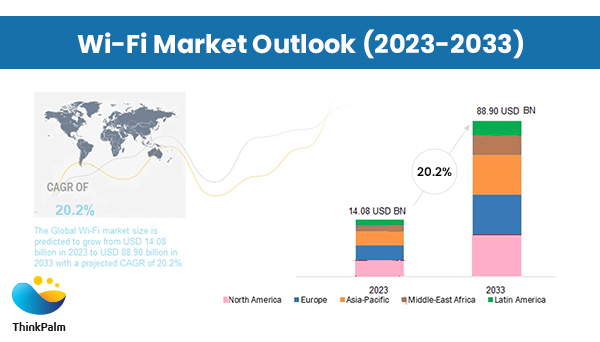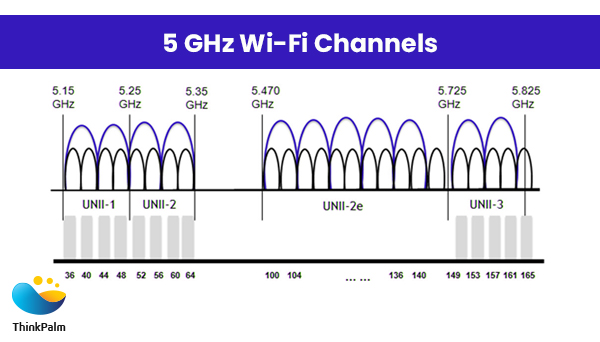Have you ever wondered how wireless testing transforms your business? Wi-Fi is a super champion that replaces cables for communication and internet access. Further, it also opened the door for cool technologies such as the Internet of Things (IoT). Today, the introduction of next-generation wireless connectivity promised by WiFi 7 ensures even more speed, low latency, and high capacity. These features help businesses transform their operations to drive growth and innovation.
As a result, wireless connectivity is everywhere! It is pushing the Wi-Fi market like never before. It has an expanded compound annual growth rate (CAGR) of 18.1% from 2018 to 2022. Moreover, the global Wi-Fi market is expected to achieve a CAGR of 20.2% by the end of 2033. Also, its market value is forecasted to be USD 88.9 billion in 2033 from a market size of USD 14.08 billion in 2023. Isn’t that pretty interesting? If you are looking to understand how advanced wireless testing services can transform your business, check out our wireless testing expertise here. 
Let’s plunge into the world of Wi-Fi. Some of the most common Wi-Fi standards include 802.11a, 802.11b, 802.11g, 802.11n (Wi-Fi 4, also known as HT), 802.11ac as VHT or Wi-Fi 5, and 802.11ax or Wi-Fi 6 termed as High-Efficiency Wireless (HE). There is a superstar standard in the making- IEEE 802.11 standard is Extremely High Throughput Generation (EHT), IEEE 802.11be otherwise WiFi 7.
It will rock the Wi-Fi arena with its faster speeds, greater spectrum efficiency, enhanced reliability, and comparatively low latency- all the good things in a single platter.
The equipment, access points, and end devices support multiple standards at the very same time. The most outstanding feature is that it is compatible with earlier Wi-Fi standards.
Let’s understand the genesis of Wi-Fi.
Wi-Fi is a set of protocols based on the IEEE 802.11 family of standards that operates on 2.4 GHz, 5GHz, and 6GHz ISM bands. From the time of its origin, Wi-Fi technology has undergone remarkable changes to become the most popular wireless connectivity technology. There were noteworthy technical enhancements in each new generation.
The IEEE 802.11 is the first-generation Wi-Fi standard introduced in 1997. It operates at a 2.4 GHz frequency band with a maximum data transfer rate of 2Mbps. 1G uses either frequency hopping spread spectrum (FHSS) or direct sequence spread spectrum (DSSS) technology.
It has three non-overlapping channels in industrial, scientific, and medical (ISM) frequency bands at 2.4 GHz.
1G is the beginning, and we should understand it is the beginning of something new and big!
For example, data inventory control in warehouses and manufacturing plants using handheld barcode scanners. Doesn’t that sound cool? Explore more on achieving endless connectivity in every situation. Read our TR-398 Wi-Fi testing plan and learn its significance in wireless testing.
Then, we have the IEEE 802.11b, which is the second-generation Wi-Fi standard introduced in 1999. It operates at 2.4GHz frequency with a maximum data speed of 11Mbps.
One of the coolest features is that it is the first Wi-Fi technology that defines high-rate direct spread spectrum (HR-DSSS) technology. Also, it uses Carrier-Sense Multiple Access with Collision Avoidance (CSMA/CA) as defined in the 802.11 base standards.
The IEEE 802.11a is the Wi-Fi technology that emerged simultaneously as 802.11b in 1999. It uses orthogonal frequency-division multiplexing (OFDM) for better signal quality because it offers reduced interference from multipath propagation of Radio Frequency (RF) signals.
Further, it makes better use of available spectrum. Do you know IEEE802.11a uses a 5GHz ISM band to give a significantly higher data speed of up to 54 Mbps?
Let’s make the Wi-Fi generation story more interesting, shall we?
As the journey progressed, in 2003, the IEEE 802.11g, the third-generation Wi-Fi standard, was introduced. It brought OFDM technology with a 2.4 GHz frequency band with a raw data rate of up to 54Mbps.
Guess what’s the best part? It is fully compatible with the former 802.11b standard.
What are the attributes that made it more popular than 2G? Of course, the lower cost and higher speed led to its popularity. Also, it quickly adapted to all devices.
Moreover, introducing personal mobile Wi-Fi devices such as smartphones led to the next wave of Wi-Fi technology. You can go through our informative blog on penetration testing that discusses the significance of ensuring fail-proof security of your wireless devices.
The IEEE 802.11n, commonly known as Wi-Fi 4, was introduced in 2009. This generation is entirely different from the earlier Wi-Fi generation. It introduced multiple input and multiple output technologies.
The focus was on better signal quality, longer range, and faster data transfer rates. Using multiple antennas to obtain higher throughput offered a maximum data rate of up to 600Mbps.
Wi-Fi 4 used both 2.4GHz and 5GHz bands and tremendously accelerated the adoption of 5GHz Wi-Fi. Also, it is compatible with its former allies 802.11b/g standards.
Furthermore, it introduced some cool new methods of MIMO antenna diversity, such as spatial multiplexing maximum ratio combining. It offers performance and efficiency enhancements over the SISO diversity antennas.
Other advanced features of Wi-Fi 4 include frame aggregation to increase efficiency and channel bonding. It allowed the use of multiple channels simultaneously to increase the data transfer rate. Do you want to know how signal interference and other factors impact wireless performance and how it can be avoided? Read our blog that discusses about RvRVO testing, to ensure high data transfer speed, regulatory compliance and better user experience while preventing that helps prevent signal interference.
Fast forward to 2013, and we have The IEEE 802.11ac, or Wi-Fi 5, It features very high throughput enhancements (VHT). Wi-Fi 5 operates at the 5GHz frequency band at theoretical speeds of up to 3.5 Gbps. Wi-Fi 5 achieved its VHT features by implementing several new and improved techniques, such as:
Wider Channels: 80 MHz and 160 MHz channels are established for even greater frequency bandwidth and higher data rates. Therefore, there is more space and hence more speed! It is just like widening a narrow path to remove congestion.
High-density modulation: the capability to avail 256-QAM modulation provides a 30 percent increase in speed over earlier modulation methods. Imagine using an automatic car instead of a manual one!
Multi-user Multiple Input Multiple Output (MU-MIMO) in the downlink: The IEEE 802.11ac is the first generation to offer multiuser communication that can transmit unique streams of independent data to multiple clients simultaneously. This results in throughput gain and better efficiency of airtime utilization.
Spatial Stream: The number of spatial streams is doubled to 8 to achieve a significant rise in speed. In the previous standard, it was limited to 4 only.
The 802.11ax, commonly known as Wi-Fi 6, was introduced in 2019 and significantly emphasized efficiency. Along with efficient utilization of available bandwidth, it offers a fourfold increase in throughput compared to its predecessor. The Wi-Fi 6 capabilities support both the 2.4 and 5 GHz frequency bands, hence providing backward compatibility to all legacy generations of Wi-Fi.
The introduction of Orthogonal Frequency Division Multiple Access (OFDMA), a multi-user version of the OFDM digital-modulation technology, is a breakthrough in the road of Wi-Fi generation.
OFDMA is a technology that partitions a Wi-Fi channel into smaller frequency allocations, called resource units (RUs), to synchronize uplink and downlink communication with multiple users simultaneously.
The introduction of a new power-saving mechanism, target wake time (TWT), offers reduced power consumption and hence enhanced battery life.
Using OFDMA, MU-MIMO in uplink and downlink transmission, and higher order modulation such as 1024-QAM modulation allows clients to achieve higher throughput and provides a theoretical maximum attainable connection speed of 9.6 Gbps.
Do you know why you should optimize your device’s firmware for Wi-Fi 6 capabilities? One of our recently published blogs on firmware engineering helps you discover its significance in 2024 and beyond.
A significant milestone of sixth-generation Wi-Fi started with the introduction of a brand-new frequency band, 6 GHz (5.925 GHz – 7.125 GHz), termed Wi-Fi 6E. With an additional 1200 MHz spectrum available for use in the 6 GHz band, Wi-Fi 6E devices will operate in 14 additional 80 MHz channels and 7 Additional 160 MHz channels. This made almost 3 times expansion around Wi-Fi spectrum usage. The broader spectrum enables Wi-Fi 6E devices to transmit data faster, with less interference and low network congestion.
The 2.4GHz spectrum can transmit signals over a long distance but has a narrower bandwidth. The frequency range of the 2.4 GHz band is split into 13 overlapping channels. Every channel occupies a unique bandwidth with its central frequency. Three distinct channels do not overlap. In the above figure, the channels 1, 6, and 11 are independent. The 2.4 GHz Wi-Fi spectrum has a 70 MHz width. The 5GHz band is split into 24 individual channels with a bandwidth of 20 MHz, and the spectrum is approximately 500 MHz wide. The 5 GHz Wi-Fi has an increased data transfer speed and wider bandwidth, providing a much quicker data connection. It can assist in high-bandwidth applications such as streaming videos.
The 5GHz band is split into 24 individual channels with a bandwidth of 20 MHz, and the spectrum is approximately 500 MHz wide. The 5 GHz Wi-Fi has an increased data transfer speed and wider bandwidth, providing a much quicker data connection. It can assist in high-bandwidth applications such as streaming videos.
The 6 GHz Wi-Fi spectrum is 1200 MHz wide and supports up to 14 additional 80 MHz channels and seven additional 160 MHz channels.
The increasingly stringent usage of Wi-Fi 6/6E in IIoT, AR/VR, robotics, and cloud gaming demands the continued evolution of Wi-Fi technology.
The IEEE 802.11be or WiFi 7, the next-generation Wi-Fi, will emerge with new technical building blocks, such as 320 MHz channels, 4K QAM modulation, multi-link operation, puncturing, and more.
It promises data rate transfer speed five times faster than Wi-Fi 6 of up to 46 Gbps with reduced latency. WiFi 7 with Extremely High Throughput, EHT will further enhance Wi-Fi capabilities and deliver higher spectrum efficiency, higher power and cost efficiency, and better interference mitigation.
Now, just look at the new technical building blocks of WiFi 7 that came up with several new methods to significantly increase performance and reduce waiting time.
WiFi 7 doubles the channel size from 160MHz to 320MHz, doubling throughput.
The number of spatial streams doubled from 8 to 16. MU-MIMO breaks the available bandwidth into separate streams that reduce congestion associated with multiple access. Also, it supports bi-directional transmission simultaneously.
You can expect up to 20% gain in throughput by increasing quadratic amplitude modulation from 1024-QAM to 4096-QAM. Pretty amazing, isn’t it?
All these enhanced features will support WiFi 7 to achieve a maximum data transfer rate of up to 46 Mbps, which is five times more when compared to 9.6 Mbps in Wi-Fi 6.
If you want to make the most of the capabilities of Wi-Fi 7 for your business, consider partnering with a reliable provider who can implement comprehensive wireless software development services. By using the advanced WiFi 7 technology, ThinkPalm’s customized wireless software development services focus on improving network efficiency by reducing latency, improving security and data transfer rate.
The major upgrade that comes with WiFi 7 is Multi-Link Operation (MLO). This allows to transmit and receive data simultaneously across multiple links. MLO offers high throughput by letting clients and APs to concurrently use multiple bands and connections (2.4 GHz, 5 GHz, 6 GHz). MLO also allows the client to switch quickly between multiple links which prevents interruptions, thereby acquiring a reduced latency.
WiFi 7 features Mesh-type configuration of the network. Guess what? It allows neighboring APs to work in coordination, improving spectrum and resource utilization.
Do you know WiFi 7 uses time scheduling to ensure reliable packet delivery? Also, its Multi-RU (Resource units) enables the puncturing of channels that elevates spectrum efficiency and avoids traffic interference on the congested channel.
Source: Wireless Broadband Alliance
The IEEE 802.11be or WiFi 7 standard will employ various new technologies and protocols to reduce waiting time, increase network performance, and boost efficiency.
It enhances the key performance indicators (KPIs) for conducting WiFi 7 field trials in real-life networks. WiFi 7 provides fast connections and better user experiences for applications such as live streaming, online gaming, and open roaming to enable seamless connectivity and Wi-Fi sensing.
It acts as a platform for mobile devices and AP vendors, operators, and service enablers to come together and test the WiFi 7 capabilities in various key deployment scenarios.
The collaborative effort provides an innovative solution for next-generation Wi-Fi standards in real-life networks and to acquire experience deploying WiFi 7 in operator, residential, and enterprise networks.
Are you looking to enhance your Wi-Fi network performance? Use ThinkPalm’s Wi-Fi capabilities To Power Up Your Business To The Next Level! ThinkPalm is your trusted ally in providing complete Wi-Fi software development and testing services that match industry standards.
At ThinkPalm, we offer Wi-Fi security testing, customization and configuration testing, interference testing, automation testing, and pre-compliance testing.
Our TR 398 Wi-Fi testing focuses on ensuring the best-in-class Wi-Fi services for home networks. We identify several performance factors, stability, and sensitivity aspects pertaining to WiFi chipsets. So, what are you waiting for? Reach out to us now and see the difference in the network performance!